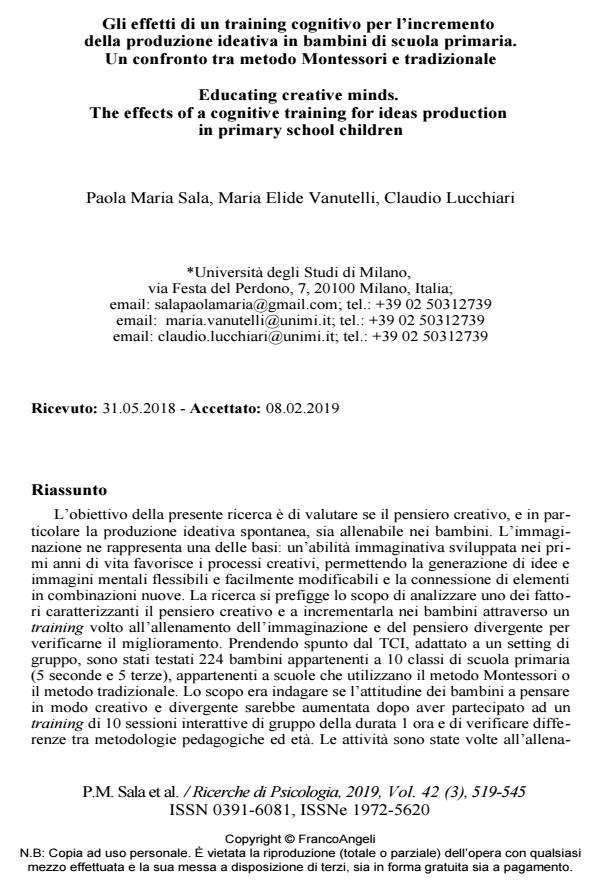Educating creative minds. The effects of a cognitive training for ideas production in primary school children
Journal title RICERCHE DI PSICOLOGIA
Author/s Paola Maria Sala, Maria Elide Vanutelli, Claudio Lucchiari
Publishing Year 2019 Issue 2019/3
Language Italian Pages 27 P. 519-545 File size 277 KB
DOI 10.3280/RIP2019-003005
DOI is like a bar code for intellectual property: to have more infomation
click here
Below, you can see the article first page
If you want to buy this article in PDF format, you can do it, following the instructions to buy download credits

FrancoAngeli is member of Publishers International Linking Association, Inc (PILA), a not-for-profit association which run the CrossRef service enabling links to and from online scholarly content.
The goal of the present research was to investigate if creative thinking can be trained in primary school children. Imagination represents one of the bases of the creative thinking process: a skilled imaginative ability, developed in early age, fosters creative processes, producing numerous and flexible mental images, easily malleable and useful to generate new ideas and combine elements in innovative ways. The study aims to analyse one of the factors of the creative thinking process, the capacity to produce ideas, and to enhance it in children through a specific 10-week training of imagination and divergent thinking. Starting from the TCI, an Italian mental reactive designed for measuring the potential of creative thinking in individual children, a different Test was made up with the objective to test 224 children belonging to 10 primary school classes (5 second grades and 5 third grades), achieving group scores. The purpose was to investigate if children’s attitude to think creatively and divergently would improve after participating to 10 interactive one-hour group training sessions. The activities were aimed at training 3 abilities - capacity to produce ideas, ability to think of many possible purposes for an object, contra-factual thinking - each measured in T0 and T1 from one part of the Test created. They were all tested in T0; afterward 8 out of the 10 classes were weekly trained, before being all 10 classes tested again in T1, 10 weeks after T0. The hypothesis was that the trained classes would have improved the capacity of producing ideas, whereas the control groups would have not. It was so verified the efficacy of the specific method to train creative thinking that was conceived, developed and administered to the children.
Keywords: Creativity, creative thinking, divergent thinking, primary school, cognitive training.
Paola Maria Sala, Maria Elide Vanutelli, Claudio Lucchiari, Gli effetti di un training cognitivo per l’incremento della produzione ideativa in bambini di scuola primaria. Un confronto tra metodo Montessori e tradizionale in "RICERCHE DI PSICOLOGIA " 3/2019, pp 519-545, DOI: 10.3280/RIP2019-003005